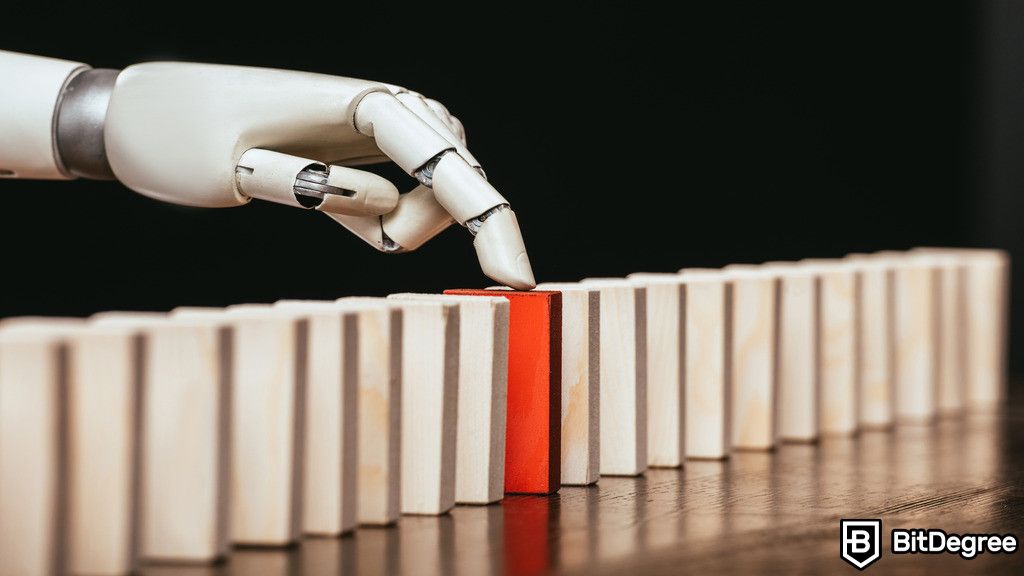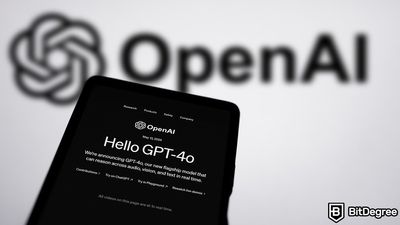Key Takeaways
- AI tries to mimic human intelligence. Machine learning, part of AI, improves by analyzing data. Deep learning digs deeper, using neural networks like our brains.
- AI cuts down on errors, works non-stop, and boosts tech interaction. Machine learning automates tasks and gets better over time, playing a big role in areas like online shopping and health care.
Free Airdrop Season 7 is LIVE! Answer fun questions or do simple tasks to earn rewards from the $30K BitDegree prize pool. Participate Now ! 🔥
At first, machine learning VS AI might sound like a mediocre idea for a 2000s science fiction movie. In reality, full of cutting-edge technology and groundbreaking innovation, these terms often come up in discussions about our future. But what do they mean, and how are they different from each other?
AI simulates human smarts, and machine learning hones skills through analyzing data. Inside the machine learning, you can find a subfield called deep learning. Here, the focus shifts to artificial neural networks, mirroring the complexity of the human brain. Today, you will learn what AI and machine learning are, and discover different ways of integrating each into your daily life.
As machine learning and AI continue to evolve, new tools designed to improve your daily life are emerging too. Among the tools I recommend trying are ElevenLabs - AI voice generator and Pictory - video creation assistant. They offer creative ways to engage with and apply AI and machine learning concepts effectively.
Are you excited about the future of AI VS machine learning VS deep learning? Great! Stay tuned until the end of this article, where you will find out the hand-picked online learning platforms that offer top-quality courses about each topic. Whether you're a beginner or an advanced learner, they cater to all levels.
Table of Contents
- 1. What is AI in Basic Terms?
- 1.1. The List of Advantages AI Offers
- 1.2. Disadvantages that Come With AI
- 2. What is Machine Learning VS AI in Basic Terms?
- 2.1. The Advantages of Using Machine Learning
- 2.2. Downsides of Machine Learning
- 3. The Most Significant Differences Between Machine Learning and AI
- 3.1. What are the Objectives of Machine Learning and AI?
- 3.2. What Methods do Machine Learning and AI use to Reach their Objectives?
- 3.3. What Are the Requirements to Build AI or Machine Learning System?
- 4. Common Applications in Various Industries
- 4.1. Healthcare and Life Sciences
- 4.2. Manufacturing
- 4.3. eCommerce
- 4.4. Financial Services
- 5. How You Can Use AI and Machine Learning in Daily Life
- 5.1. Personalized Content Recommendations
- 5.2. Photo Organization and Enhancement
- 5.3. Language Translation
- 5.4. Health and Fitness Monitoring
- 6. Top MOOC Providers to Learn Machine Learning and AI From
- 6.1. Beginners Guide to AI (Artificial Intelligence) (Enroll Here)
- 6.2. Understanding Machine Learning (Enroll Here)
- 6.3. Generative AI Fluency (Enroll Here)
- 7. Conclusions
What is AI in Basic Terms?
The term "artificial intelligence" refers to the computer systems that can perform tasks that typically require human brains to process. They include, but are not limited to, learning, problem-solving, reasoning, speech recognition, and language understanding. Note the terms; they will be needed to evaluate AI or machine learning later.
Latest Deal Active Right Now:Equip your entire team with this 30% QuillBot Premium discount code! Enhance your team's writing efficiency today.
I would not surprise you by saying that the history of artificial intelligence did not start with the invention of ChatGPT. Interestingly, there's evidence laid down in the myths and stories about people discussing the possibility of self-thinking machines since the days of old.
It is truly fascinating that AI has roots deep in centuries of human imagination! However, it was not until the last few decades that people developed and actively pursued an understanding of it.
The concept of a computer program that acts like a human brain sounds intriguing, doesn’t it? Nonetheless, AI is full of both opportunities and challenges, demanding careful consideration of ethical consequences. On that note, it's an ideal time to review the best and the worst AI can offer.
The List of Advantages AI Offers
Artificial intelligence has revolutionized the way we interact with technology, making it smarter and more intuitive than ever before. With AI, we can now complete tasks and retrieve information with just a few keyboard clicks or spoken words. Here are a few areas where it excels the most.
- Reduction in human errors: One of the biggest benefits of AI VS machine learning is a significant reduction in errors and enhanced accuracy. This is achieved by using data and algorithms. Applications such as robotic surgery systems ensure precision and improve patient safety.
- 24/7 availability: Unlike humans, AI can work all day without breaking a sweat. It is an ideal candidate for tasks that require constant attention. For instance, online customer support chatbots offer assistance day and night. Round-the-clock availability guarantees instant help to users, improving overall customer satisfaction.

- Security augmentation: AI can efficiently identify fraudulent activities by analyzing patterns in large datasets. Financial institutions profit from AI algorithms that enhance security and simplify the fraud detection process. By doing that, the need for human intervention is highly reduced.
- New inventions: AI can also be a driving force behind innovations, contributing to tremendous discoveries. Early breast cancer detection in healthcare, the development of self-driving cars, revamping transportation, and improving road safety. These are only a few examples of what AI and human power combined can invent. Hopefully, many more will come soon.
Disadvantages that Come With AI
Various aspects of our lives have been upscaled by AI. However, it is important to acknowledge that there are also some drawbacks. From ethical concerns regarding privacy to the potential loss of job opportunities, AI brings certain challenges that we must carefully consider.
- Existential threats(?): Can a highly intelligent AI pose an existential threat to humanity? While we do not know the answer yet, worries rose in May 2023 when the nonprofit research organization Center for AI Safety released a short statement: "Mitigating the risk of extinction from AI should be a global priority alongside other societal-scale risks, such as pandemics and nuclear war."
- Job displacement: Between 2000 and 2010, the U.S. lost around 5.6 million blue-collar positions, generally because of computerization. The effect of man-made intelligence on work has been felt across different areas, including retail, transportation, and client assistance. The World Economic Forum predicts that AI may replace around 85 million jobs by 2025.

- Making humans lazy: The sudden rise of AI has significantly changed how we approach tasks. AI, designed to simplify processes and improve efficiency, has undoubtedly succeeded in various aspects of our lives. From automating everyday chores to handling complex calculations, AI systems have taken on roles that traditionally require human effort. That shifted human behavior towards increased dependence on technology for various tasks.
- Ethical concerns: The more general ethical concerns surrounding AI include data privacy, information misuse, and the role of tech giants. As AI advances, the interaction between technology and morality grows more complex. This contributes to a tricky question about the responsible use of artificial intelligence in society.
You get it now: AI isn't just a chatbot. Developing one might require a deep understanding of programming, human behavior analysis, and a constantly changing view of ethics.
AI encompasses the fields of computer vision, robotics, machine learning, automated reasoning, knowledge representation, and natural language processing[1]. Among these, machine learning interests us the most. What makes it so special?
What is Machine Learning VS AI in Basic Terms?
The Oxford Learners Dictionary defines machine learning as "the type of artificial intelligence in which computers use huge amounts of data to learn how to do tasks rather than being programmed to do them."
Answering the "What is machine learning VS AI?" question, machine learning is like the child of an AI. To be more specific, a branch that focuses on algorithms and can learn from and adapt to various data. While AI is the wall-to-wall concept seeking to create intelligent machines, machine learning is a direction within AI that enables systems to learn and improve their performance autonomously.
Standardly, ML is subdivided into 3 categories: supervised learning, unsupervised learning, and reinforcement learning. Different qualities of each help to resolve various problems in different scenarios.

One machine learning technique worth highlighting is deep learning, which layers algorithms into what is called an artificial neural network. The deep neural networks are very similar to the structure of the human brain.
Unlike machine learning, deep learning requires little to no human interaction and is capable of advancing on its own using neural network systems.
Imagine computers learning from data to emulate human thought processes. Considering the roots of machine learning can help us foresee that it might be far from perfect yet. However, there are many areas it is good at. Could you guess any of those?
The Advantages of Using Machine Learning
Machine Learning has revolutionized technology and become an integral part of various industries. It offers numerous advantages that have transformed the way we live and operate businesses.
- Automation without human intervention: Machine learning streamlines project management by allowing machines to learn, predict, and refine algorithms. Notably, anti-virus software exemplifies this, autonomously recognizing and filtering threats and excelling in spam identification without constant human oversight.
- Wide range of applications: Machine learning's versatility shines across industries, such as eCommerce and healthcare, enhancing customer experiences and targeting specific audiences. A prime example is Amazon's use of ML to grasp user behaviors to deliver personalized recommendations and advertisements.

- Continuous improvement: Various algorithms continuously refine accuracy and efficiency through experience. In applications like weather forecasting, as datasets expand, algorithms swiftly improve predictions, showcasing ML's inherent continuous enhancement.
- Handling multi-dimensional data: Machine learning's adaptability shines in managing complex, multi-dimensional data in dynamic environments. Across different areas, these algorithms effectively handle and extract insights from data of varying types and dimensions.
Downsides of Machine Learning
Like any technology, machine learning also has its own set of disadvantages. Exploring the potential drawbacks of ML can shed some light on the challenges you might face while using this powerful technology.
- Data privacy concerns: Machine learning algorithms are designed to process massive amounts of diverse information. If not carefully revised, the collection and use of personal data can raise privacy and security concerns. Sometimes data breaches happen, and while no one expects that, the leak of sensitive personal details can cause significant drawbacks in the trust of machine learning applications.
- Initial costs and resources: Creating machine learning solutions requires a significant investment in technology, infrastructure, and manpower. Developing and training machine learning models demands deep technical expertise and resource allocation for data acquisition, cleaning, and preparation. The initial costs can be off-putting for smaller businesses and individuals.

- Difficult to decipher: Machine learning models can be complex and challenging to understand, especially if deep learning algorithms are used. This lack of transparency can make it hard to understand why certain decisions were made, creating setbacks in building trust in automated systems.
- Ethical concerns and social changes: Machine learning algorithms can unintentionally keep biased information in the training data. This can lead to unjust outcomes, raising ethical concerns. Businesses must carefully design and monitor their machine-learning systems to ensure they do not increase or dilate existing biases.
Technology is bringing numerous social changes into our day-to-day lives, affecting our thought processes and creating undesirable problems. The removal of individuals from their jobs and the leaks of sensitive details are going to be serious problems if not handled properly.
Well, does the difference between machine learning and AI seem to be bigger than you thought at the beginning, or, perhaps - smaller? Let’s go further and compare them side by side.
The Most Significant Differences Between Machine Learning and AI
Artificial intelligence and machine learning have recently experienced an enormous breakthrough. This led to major changes in business and the daily lives of billions of people. While both technologies share similar core ambitions - to reduce human workload by empowering machines and computers - approaches to solving this problem are quite different.
While there are many criteria by which they can both be compared, we will take a look into the difference between machine learning and AI regarding their objectives, methods, and requirements.
What are the Objectives of Machine Learning and AI?
AI has set a goal to imitate human intelligence in computers. To achieve that, it’s delegating them to complete complex tasks and make decisions autonomously. The AI aims to fit a range of applications, including but not limited to problem-solving, human language interpretation, and learning from past experiences.

Machine learning focuses on developing algorithms and statistical models that help machines perform tasks without direct programming. The prime purpose of machine learning technology is to improve systems performance over time by providing them with more learning data.
What Methods do Machine Learning and AI use to Reach their Objectives?
AI has a broad scope of techniques, including rule-based systems, expert systems, and symbolic reasoning, in addition to machine learning. It incorporates various methods to mimic human cognition, such as knowledge representation, planning, and problem-solving.
Machine learning specifically emphasizes the use of statistical methods to help machines learn and make decisions without being explicitly programmed. Machine learning includes three main methods: supervised learning, unsupervised learning, and reinforcement learning.
What Are the Requirements to Build AI or Machine Learning System?
AI system development often requires a combination of domain knowledge, logical reasoning, and problem-solving skills. AI applications incorporate rule-based programming, knowledge input, and diverse methodologies to complete specific tasks.
Machine learning requirements include large data collection for training, confirmation, and testing. One of the drawbacks is the constant need for specialists to design, train, and fine-tune machine learning models. Also, the quality and variety of the data can greatly impact the performance of the algorithms.
Below you can find a table that summarizes the difference between machine learning and AI:
| Criteria | Machine learning | AI |
|---|---|---|
| Objectives | Improve system performance | Imitate human intelligence |
| Methods | Supervised learning, unsupervised learning, reinforcement learning | Rule-based systems, expert systems, symbolic reasoning |
| Requirements | A large amount of data collection for training, confirmation, and testing | Domain knowledge, logical reasoning, and problem-solving skills |
Table: Key differences between machine learning and AI
The purpose and differences between machine learning VS AI are finally clear. Further, let's see how the difference between AI and machine learning helps to shape global business development.
Common Applications in Various Industries
Recently, various companies started integrating automation solutions to improve their business operations. AI and machine learning have become widely used in healthcare, finance, manufacturing, and other fields. Let’s see what impact it has created since.
Healthcare and Life Sciences
There is a key difference between AI and machine learning in healthcare. ML is mostly used for preventative tactics such as disease prediction using the history of past patients. On the other hand, AI is being developed to help in curative healthcare.
The healthcare and life sciences industries are witnessing significant interest and investment in AI. It’s leveraged to create more effective drugs, enable robot-assisted surgeries, identify patients who are ready for treatment, and improve outcomes.

Machine learning's strength lies in its ability to analyze huge datasets, identify patterns, and make predictions. Meanwhile, AI excels in its capacity to understand complex medical scenarios, assist in decision-making processes, and automate tasks that boost overall efficiency.
There is no machine learning VS AI here. When human life is at stake, both technologies work together.
Manufacturing
Traditional machines used in factories can be efficient; however, they require constant human oversight. Supplying them with an autonomous mind can minimize the resources and costs needed, therefore lowering the price of manufactured products. This is where a cobot, or collaborative robot, comes into play - a device designed for direct human-robot contact within a shared workspace.
The primary skill required of cobots is machine learning - the ability to freely improve their skills through gaining experience. Machine learning enables cobots to make predictions and, thus, make their own decisions.
Replacing human workers is not a priority for most organizations. AI helps explore ways to increase human abilities and allow us to work more safely and efficiently.
eCommerce
Natural language processing (NLP) is a machine-learning technology that allows computers to interpret, manipulate, and understand human language.
NLP used in eCommerce websites, utilizes past user data like purchase history, search patterns, and overall behavior to personalize product recommendations. AI-powered features like “Often bought together” or “Customers recently viewed” can suggest accompanying products based on color, size, or brand.
Market demand, competitor pricing, and economic conditions. These are just a few variables that need to be considered when starting a business. Once again, AI has a solution for it: dynamic pricing.

This strategy allows you to respond to market conditions by adjusting your prices swiftly. It can also help you by predicting optimal discount options and adaptively picking the minimum discount required to drive profit.
Financial Services
The financial industry has also revamped traditional solutions such as manual data analysis and rule-based systems with the help of artificial intelligence. Powerful algorithms are exploited to quickly process multiple data sources, decrypt patterns, and create programs that can predict future outcomes.
As technology advances, best practices and trends evolve, too. Companies attached to traditional outlooks find it challenging to keep up with competitors. While those who adopt new technological shifts snowball their growth in the market.
Enough about industry; let’s see how AI VS machine learning compare in our day-to-day activities.
How You Can Use AI and Machine Learning in Daily Life
Ever wondered how the difference between machine learning and AI can uniquely help you in your daily life? Check out a few hand-picked use cases worth mentioning today.
Personalized Content Recommendations
AI algorithms are capable of analyzing data such as browsing history, search manners, and content watch patterns to understand your preferences and what attracts you the most. This information can then be used to suggest content that is most likely to catch your attention.
Whether it's movies, books, or music, these technologies analyze your past choices and behaviors to offer targeted recommendations. Enjoy an enhanced entertainment experience as you explore new content aligned with your taste.
Photo Organization and Enhancement
The camera is one of the most used apps on our phones. Have you noticed that it can easily identify what object you are pointing at, whether it is a dog, a flower, or your buddy? But how?
The technology behind the lens uses computer vision algorithms to analyze and translate visual data captured by the camera and label the objects in focus. The gallery on your phone also uses similar labels to organize precious moments of your life in separate folders.

Would you like to sprinkle some spice on your bland photos using AI? There are various websites and apps to choose from that are equipped with advanced image processing capabilities. Platforms like Adobe Photoshop, Google Photos, and Snapseed offer user-friendly interfaces with AI-driven features.
You can use these tools to enhance colors, apply filters, and even remove unwanted elements from your photos. Additionally, services like Dall-E and Prisma use AI algorithms to transform your photos into stunning artwork.
Language Translation
According to Google, switching to a deep learning model produced 60% more accuracy than the old Google Translate engine[2], which used phrase-based machine translation.
A decade ago, no one would have thought that breaking the language barrier would be so simple. Everything has changed since the dawn of AI-driven language translation. Now, we can translate entire texts in seconds, accurately recognizing phrases, nuances, and cultural references.
Whether you need accurate localization for your website or application or want to impress your foreign friends with a natively written birthday wish, AI translation tools like Google Translate and DeepL can help you with either.
Health and Fitness Monitoring
From tracking physical activity to monitoring vital signs, AI provides insights and suggestions for maintaining a healthier lifestyle. AI enables real-time breakdown of the collected data, offering more accurate readings and adapting to individual preferences. This translates into a more personalized fitness tracking experience where users receive recommendations and feedback on their progress.
For example, the Fitbit Versa utilizes AI to provide customized insights based on factors like physical activity, heart rate, and sleep patterns, aligning with users' fitness goals.

Right, it looks like we are almost done with theory; let’s practice. AI VS machine learning VS deep learning: choose whichever you like more. I gathered the top-notch courses that are not only beginner-friendly but also informative.
Top MOOC Providers to Learn Machine Learning and AI From
Have you ever found yourself intensively browsing the internet with a question like "What is the difference between machine learning and AI?" but nothing valuable came up? You are lucky today; check out these three courses, which will supply you with initial knowledge. After completion, you will be able to easily decide which one you like more: machine learning VS AI.
Beginners Guide to AI (Artificial Intelligence) (Enroll Here)

- Platform: Udemy
- Duration: 39 minutes
- Price: $24.99
- Certificate: Yes
- Level: Beginner
- Discount: Available
- Where to apply? HERE
Let’s start with the basics. Beginners Guide to AI course from Udemy covers fundamental concepts such as social intelligence, machine intelligence, and the basics of AI and machine learning.
Designed for anyone interested in learning AI, the course explores how it allows machines to emulate human thinking processes and actions.
If you are new to this topic, choosing which interests you more might be challenging: AI or machine learning. This course provides a complete overview for all levels of learners.
What you'll learn:
Artificial intelligence. The foundations of AI, its origins, and its evolution into a system that emulates human thinking processes and actions. Gain insights into its widespread applications in our lives.
Algorithms and neural networks. What’s the role of algorithms and neural networks in AI? Learn how complex algorithms and networks are bending the future path of AI.
Different parts of artificial intelligence. Unpack the components of AI, including reasoning, natural language processing, and machine learning.

Developments and uses in the world of AI. Real-world applications of AI in speech and language recognition, facial recognition, surveillance, healthcare, and robotics. Understand AI's potential to augment, rather than replace, human jobs.
This course is suitable for everyone interested in the "machine learning VS AI" topic. Whether you're a novice curious about AI or someone seeking to enhance their understanding of machine intelligence, Siim Õunap's Beginner's Guide to AI (Artificial Intelligence) is a great start. Enroll now to solve the mysteries behind AI VS machine learning and their impact on our lives.
Understanding Machine Learning (Enroll Here)

- Platform: DataCamp
- Duration: Self-paced
- Price: From $25/month
- Certificate: Yes
- Level: Beginner
- Discount: Available
- Where to apply? HERE
The Understanding Machine Learning course provides a non-technical introduction to machine learning concepts, offering accessible learning for those new to the “machine learning VS AI” field. You will gain insights into the basics of machine learning, its relation to data science and artificial intelligence, and the fundamental terminology associated with it.
Through hands-on exercises, you will dive into the machine learning workflow for building models and understanding the various types of ML. As a little bonus, methods for evaluating and improving these models are included, too!
The course concludes with an introduction to deep learning, exploring its applications in computer vision and NLP.
What you'll learn:
What is Machine Learning? This free chapter explores the fundamentals of machine learning and its relationship with data science and AI. Discover key terms and learn how to start model-building.
Deep Learning. Starting with neural networks, explore typical use cases: computer vision and natural language processing. Conclude by acknowledging the limits and dangers of machine learning.

Machine Learning Models. Take a deep dive into machine learning basics, exploring different types of machine learning. Learn how to evaluate and improve your models under the guidance of experienced instructors.
Lis Sulmont, with a Master's degree in Computer Science; Hadrien Lacroix, a curriculum manager at DataCamp; and Sara Billen, a seasoned data scientist. Together, these instructors form an exceptional team dedicated to guiding you through the intricacies of machine learning concepts.
The course is for everyone curious about machine learning VS AI, regardless of background or experience level. Enroll now and unravel the potential they hold.

- Free to use
- Add-ons for Microsoft Word and Chrome
- Wide selection of tools
- Extensions for Chrome and Edge browsers
- Some tools are free
- Easy to use

- Supports over 120 voices in 20 languages
- Live customer support
- Voice cloning feature
- Voice cloning
- Emphasis and pauses
- Background music

- Easy to use
- AI-powered tools
- Cross-platform integration
- Multitrack editing
- AI-powered editing
- Accurate transcription
Generative AI Fluency (Enroll Here)

- Platform: Udacity
- Duration: 7 hours
- Price: From $249/month
- Certificate: Yes
- Level: Beginner
- Discount: Available
- Where to apply? HERE
The Generative AI Fluency course is your gateway to mastering Generative AI. It kicks off with the basics, making sure you're set up to understand how it all works. You'll learn about large language models for text generation and diffusion-based models for creating images.
What you'll learn:
The course is packed with practical lessons. You get to try out tools like DALL-E and Midjourney firsthand and learn how to deploy generative AI applications effectively, covering everything from data collection to system maintenance.
Your instructors are top-notch experts who've been in the big tech. They're ready to pass on their knowledge and help you navigate the complexities of generative AI.

You don't need any prior experience to start this course. It's a 7-hour ride, complete with a certificate once you're done. This course prepares you to use generative AI confidently in any setting.
Eager to tap into the power of AI? Sign up now and begin your training with the best in the field.

Did you know?
Have you ever wondered which online learning platforms are the best for your career?
Conclusions
Let's wrap up today's comparison: Is there a significant difference between machine learning VS AI? The primary distinction lies in their functionalities. AI seeks to mimic human intelligence, while machine learning works at independently learning from large datasets.
In practical applications, the fusion of AI and machine learning blurs boundaries, from healthcare predictions to manufacturing collaborative robots. Individuals leverage these technologies for personalized recommendations, fitness monitoring, and more. As the future unfolds, the ultimate winner may be the seamless integration of both. Everything boils down to your specific needs and goals.
Curious to explore AI or machine learning? Ready to discover deep learning? Enroll in beginner-friendly courses from the section above and don't forget to check out ElevenLabs and Pictory tools to practically apply the concepts that you learned!
The content published on this website is not aimed to give any kind of financial, investment, trading, or any other form of advice. BitDegree.org does not endorse or suggest you to buy or use any kind of AI tool. Before making financial investment decisions, do consult your financial advisor.
Scientific References
1. Almeida Jr. S. A., Guner S.: 'Review of Artificial Neural Networks and A New Feed-Forward Network for Anchorage Analysis in Cracked Concrete';
2. Wu Y., Schuster M., Chen Z., et al.: 'Google's Neural Machine Translation System: Bridging the Gap between Human and Machine Translation'.











